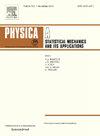Cascading failures in multiple-to-multiple interdependent networks considering interdependent failure threshold
IF 2.8
3区 物理与天体物理
Q2 PHYSICS, MULTIDISCIPLINARY
Physica A: Statistical Mechanics and its Applications
Pub Date : 2025-06-06
DOI:10.1016/j.physa.2025.130712
引用次数: 0
Abstract
In recent years, the study of interdependent networks has emerged as a focus within the field of complex networks. In analyses of the robustness of networks with multiple support-dependent relationships, traditional interdependent failure rules often assume that a node fails when one or all of its interdependent nodes fail. Such assumptions often fail to capture the probabilistic nature of real-world network failures. More generally, interdependent networks in the real world typically exhibit failure dynamics in which a node fails if a certain proportion of its interdependent nodes fail. To address this fact, this paper proposes a model of multiple-to-multiple interdependent networks that introduces an interdependent failure threshold, defined as the proportion of failed interdependent nodes required to trigger the failure of a given node. The study investigates how the varying number of interdependent edges and the interdependent failure threshold influence the robustness of the network under random or intentional attacks. In intentional attacks, the robustness of the network decreases as the number of interdependent links increases. Additionally, assortatively coupled networks demonstrate greater robustness under random attacks, while randomly coupled networks are more robust under intentional attacks. Finally, we verify the correctness of our results in real-world settings and obtain conclusions that are basically consistent with the theoretical model. These findings provide valuable information on the resilience mechanisms of interdependent networks in the real world, which has implications for the design of more robust systems.
考虑相互依赖故障阈值的多对多相互依赖网络中的级联故障
近年来,相互依赖网络的研究已成为复杂网络领域的一个热点。在分析具有多个支持依赖关系的网络的鲁棒性时,传统的相互依赖失效规则通常假设当一个或所有相互依赖的节点失效时,一个节点失效。这样的假设往往无法捕捉到现实世界网络故障的概率性质。更一般地说,现实世界中的相互依赖网络通常表现为故障动态,其中如果其相互依赖节点的一定比例失效,则节点失效。为了解决这一问题,本文提出了一个多对多相互依赖网络的模型,该模型引入了一个相互依赖的故障阈值,定义为触发给定节点故障所需的相互依赖节点故障的比例。该研究探讨了在随机或故意攻击下,不同数量的相互依赖边和相互依赖的故障阈值如何影响网络的鲁棒性。在故意攻击中,网络的鲁棒性随着相互依赖链路数量的增加而降低。此外,分类耦合网络在随机攻击下表现出更强的鲁棒性,而随机耦合网络在故意攻击下表现出更强的鲁棒性。最后,我们在实际环境中验证了结果的正确性,得到了与理论模型基本一致的结论。这些发现为现实世界中相互依赖网络的弹性机制提供了有价值的信息,这对设计更健壮的系统具有重要意义。
本文章由计算机程序翻译,如有差异,请以英文原文为准。
求助全文
约1分钟内获得全文
求助全文
来源期刊
CiteScore
7.20
自引率
9.10%
发文量
852
审稿时长
6.6 months
期刊介绍:
Physica A: Statistical Mechanics and its Applications
Recognized by the European Physical Society
Physica A publishes research in the field of statistical mechanics and its applications.
Statistical mechanics sets out to explain the behaviour of macroscopic systems by studying the statistical properties of their microscopic constituents.
Applications of the techniques of statistical mechanics are widespread, and include: applications to physical systems such as solids, liquids and gases; applications to chemical and biological systems (colloids, interfaces, complex fluids, polymers and biopolymers, cell physics); and other interdisciplinary applications to for instance biological, economical and sociological systems.

 求助内容:
求助内容: 应助结果提醒方式:
应助结果提醒方式:


